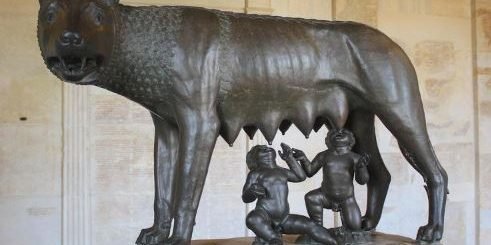The Dark side of Rome’s Cultured Façade
Exploring the dark side of Rome’s cultured façade involves peeling back the layers of its illustrious history to reveal the complexities and contradictions of an empire that has captivated the imagination of the world for millennia. Rome, known for its monumental achievements in law, architecture, and governance, also harbors a history rife with violence, oppression, and moral decadence.
In this exploration, World History Edu will traverse through various epochs of Roman history, examining how beneath the surface of its celebrated achievements lay a society grappling with profound ethical and social challenges.
Foundations in Blood and Ambition
The story of Rome begins with myth and bloodshed. Romulus’ murder of Remus, a foundational myth, encapsulates the violence that often accompanied Rome’s expansion and consolidation of power.
As the Republic flourished, it was frequently at the expense of conquered peoples. The Roman legions, symbols of discipline and martial prowess, were also agents of destruction and subjugation.
Cities like Carthage were razed, and their inhabitants slaughtered or sold into slavery, showcasing Rome’s ruthless pursuit of dominance.
Conflict between Romulus and Remus over the founding of Rome
Patrician vs. Plebeian: A Divided Society
The internal social structure of Rome was marked by sharp divisions and inequities. The patricians and the plebeians, two distinct social classes, were often at odds.
While the Republic boasted institutions that suggested a form of democratic representation, such as the Senate and the Assembly, real power was frequently concentrated in the hands of a few wealthy families.
The plebeians, despite forming the majority of the population, struggled for political representation and economic fairness, leading to the Conflict of the Orders, which saw plebeians fighting for, and gradually obtaining, more rights.
READ MORE: The Five Good Emperors and Their Accomplishments
Slavery: The Economy’s Dark Engine
Slavery was a cornerstone of the Roman economy and a grim testament to its moral contradictions. Slaves were considered property and were often subjected to brutal treatment.
They worked in households, fields, public baths, and mines; and even educated slaves were not spared from the degradation of their status. The widespread acceptance of slavery highlighted a deep-seated devaluation of human life, which was at odds with Rome’s philosophical and legal advancements.
READ MORE: 5 Most Terrible Roman Emperors

Image: An ancient artwork showing two female slaves serving their mistress.
The Arena of Death: Gladiatorial Games
The Colosseum, Rome’s architectural marvel, was also a stage for gruesome spectacles. Gladiatorial games, celebrated as festive occasions, involved combat between gladiators, often slaves or prisoners of war, who fought to the death for the entertainment of the populace. These games reflect the normalization of violence in Roman society and the populace’s desensitization to human suffering.

Image: The Colosseum, located in the center of Rome.
Roman Emperor Commodus – Life, Reign, Atrocities Committed, & Assassination
Decadence and Moral Decay among the Elite
The lives of the Roman elite were often marked by opulence and moral laxity. Figures like Nero and Caligula are emblematic of the decadence that could fester in the higher echelons of power. Extravagant parties, political assassinations, and incestuous relationships were reported among the elite, indicating a society where excess and moral decay were intermingled with political governance.
What was Rome’s Crisis in the 3rd Century? – Causes and Major Effects
Religious Persecution: The Shadow of Orthodoxy
As Christianity began to spread within the empire, it initially faced intense persecution. Christians were often scapegoated for societal woes and faced horrific punishments, including being thrown to lions. The persecution of Christians highlights a darker aspect of Roman religious life, where deviance from established religious norms was met with extreme hostility.

History of the Catholic Church: How and When Did Catholicism Begin?
Administrative Corruption and the Decline
Corruption was rife in the administrative mechanisms of Rome. Governors and other officials often exploited their positions for personal gain, leading to widespread injustice. Such corruption not only undermined the efficiency of the empire but also contributed to its decline, as disillusionment and fiscal crises became rampant.
Theodosius I: The Anti-Pagan Roman Emperor who made Christianity the Official State Religion
The Legacy of Contradictions
The dark aspects of Rome’s history provide a counterbalance to its celebrated cultural and intellectual achievements. Understanding these elements is crucial in painting a fuller picture of Roman society—one that recognizes its monumental contributions to Western civilization but also its failures and vices.
This nuanced view reminds us that the splendor of Rome, like that of many great civilizations, was deeply intertwined with shadows that challenge the simplistic glorification of its legacy.
The true essence of Rome, therefore, lies in its complexities and contradictions, making it a perennial subject of study and reflection in the quest to understand the human condition.
Why did Roman Emperor Constantine the Great convert to Christianity?



























